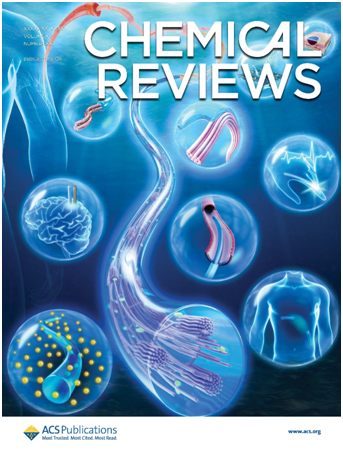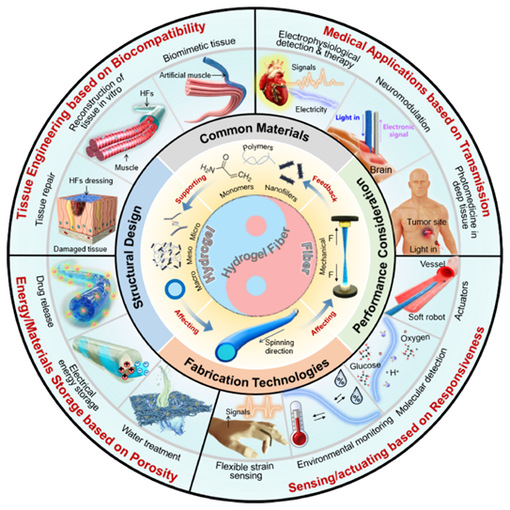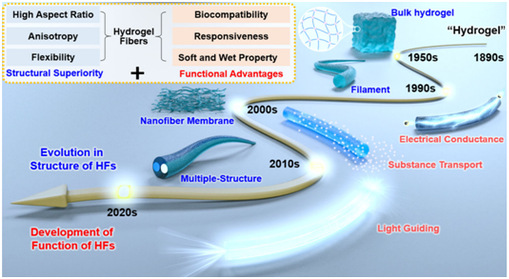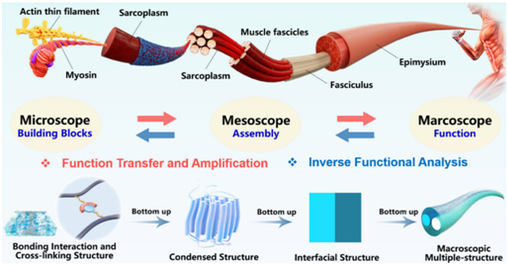Recently, Chemical Reviews published online a review paper on the development history and research progress of hydrogel fibers written by Academician Zhu Meifang's team from the College of Materials Science and Engineering and the State Key Laboratory of Advanced Fiber Materials of the University, and it was selected as the front cover of the current issue (Figure 1). The relevant article, titled ‘A Review of Hydrogel Fiber: Design, Synthesis, Applications, and Futures’, was written by academician Zhu Meifang, associate researcher Hou Kai, associate researcher Chen Guoyin, and Donghua University as the sole correspondent. The article unites the exploratory experience and technical accumulation of Academician Zhu Meifang's team in hydrogel fiber forming and application for more than ten years.

Figure 1: Current issue cover
Hydrogel fibers are materials that combine the softness, wettability, biocompatibility and environmental responsiveness of hydrogel materials with the high aspect ratio, anisotropy and flexibility of fiber materials. This material has a wide range of potential applications in biomedical, energy, and environmental sciences due to its unique structural and functional properties. In nature, a wide variety of hydrogel fibers exist in living organisms, such as muscle tissue, nerve tissue, and connective tissue. These tissues exhibit special functions and multilevel structures that carry the mystery and potential of life activities. From fibrous tissues in the body, such as nerves and muscles, to various animal hairs in vitro, these hydrogel fibers not only facilitate the transmission of biological signals in vivo, promote cell differentiation and other functions, but also provide protection and defense against external threats. Therefore, understanding and mimicking the ordered nanocomposite structures and multilayered organization in living organisms is the focus and challenge of hydrogel fiber development. Accordingly, this article systematically reviews the research progress of hydrogel fibers, covering various aspects of hydrogel fibers in terms of raw material selection, structural design, fiber shaping, performance evaluation, functional applications, and future perspectives (Fig. 2), to provide guidance for future research and to promote the application and development of hydrogel fibers in multiple fields.

Figure 2. Overview diagram of hydrogel fibers from design, synthesis to application
The term “hydrogel” dates back to the late 19th and early 20th centuries and was originally used to describe colloids of certain inorganic salts. Later, as the field evolved, hydrogel came to mean something different from its original meaning, which was primarily a physically or chemically cross-linked polymer capable of swelling in water or biological fluids. In the early stages of hydrogel development, from the 1950s to the 1990s, research on hydrogels focused on the swelling of the raw materials used to prepare hydrogels, the control of the internal network of hydrogels, and the basic properties of hydrogel materials (swelling, mechanical properties, etc.). And during this research period, regarding the morphology of hydrogel is usually in block form, while in terms of functionality, it has realized temperature-sensitive response, pH response, drug release and so on. By the 1990s and the beginning of the 21st century, hydrogel fibers were gradually developed using wet-spinning technology and widely used for environmental response and actuation. Subsequently, hydrogel fibers entered a period of rapid development (Figure 3). Briefly, in terms of structure, hydrogel fibers have gradually developed from a single structure to multiple structures, such as monofilaments, nanofibrous membranes, and multistructured hydrogel fibers. At the same time, hydrogels with multiple functions have been gradually developed, including substance transport, electrical conductivity, and photoconductivity. Based on the development of these functions, the application fields of high-frequency fibers have been greatly expanded, such as signal sensing, tissue repair, and biomimicry. Therefore, the construction of high-performance hydrogel fibers with complete structures and functions is crucial for the development of various fields, and a systematic review of the development of hydrogel fibers is of great significance in guiding the future functionalization and intelligence of hydrogel fibers.

Figure 3. Evolution of hydrogel fibers
The article discusses in detail the common materials used for hydrogel fibers, including natural polymers (e.g., sodium alginate, chitosan, cellulose, etc.), synthetic polymers (e.g., poly(vinyl alcohol), poly(N-isopropyl acrylamide), monomers/oligomers, and nanoparticles. The selection of these materials has a significant impact on the performance and functionality of hydrogel fibers. Further, the importance of the structural design of hydrogel fibers on their performance and functionality was emphasized (Figure 4). The structural design includes microstructures (e.g., crosslinked networks, pore structures), mesostructures (e.g., multi-network structures, oriented structures), and macrostructures (e.g., hollow structures, core-shell structures, etc.). And in the synthesis of hydrogel fibers, various preparation techniques of hydrogel fibers are discussed in detail, including wet spinning, microfluidic spinning, dynamic polymerization spinning, 3D printing, and so on. Each of these techniques has its own advantages and disadvantages and is suitable for different application scenarios. Subsequently, based on the structural and functional characteristics of hydrogel fibers, the article discusses in detail the applications of hydrogel fibers in several fields, including biomedical (e.g., tissue engineering, drug delivery), energy (e.g., supercapacitors, batteries), and environment (e.g., water treatment, pollutant adsorption). These applications demonstrate the versatility and wide range of applications of hydrogel fibers.

Fig. 4. Principles of hydrogel fiber design
The article concludes that although hydrogel fibers have made significant progress in material design, structural design and functional construction, they still face some challenges. Future research will pay more attention to the directions of multifunctional integration, biocompatibility and degradability, intelligence and dynamic response of hydrogel fibers. These research directions will promote the application and development of hydrogel fibers in more fields.
This research paper was supported by the Key Research and Development Program of the Ministry of Science and Technology, the National Natural Science Foundation of China, and the Shanghai ‘ChenGuang Program’, etc. Chemical Reviews is a top-tier academic journal of the American Chemical Society, dedicated to publishing comprehensive, authoritative, critical, and readable reviews of recent important research in chemistry-related fields. Founded in 1924 and published since then, it is one of the most respected and highly ranked journals in the field of chemistry.
